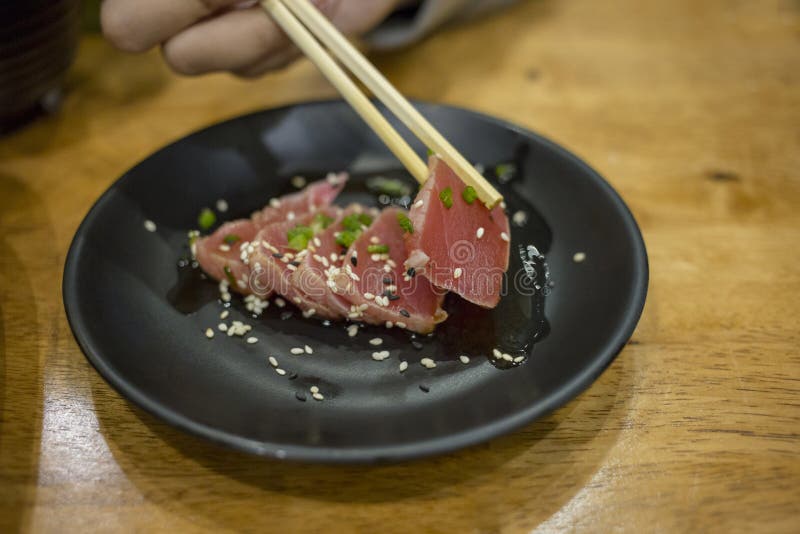
Wasabi paste is sometimes mixed directly into soy sauce as a dipping sauce, which is generally not done when eating sushi (which itself normally includes wasabi). Sashimi is popularly served with a dipping sauce ( soy sauce) and condiments such as wasabi paste, grated fresh ginger, grated fresh garlic, or ponzu for meat sashimi, and such garnishes as shiso and shredded daikon radish. The typical garnish is Asian white radish, daikon, shredded into long thin strands, or single leaves of the herb shiso ( perilla) The sliced seafood that composes the main ingredient is typically draped over a garnish. Japanese chefs consider sashimi the finest dish in Japanese formal dining and recommend that it be eaten before other strong flavors affect the palate. Sashimi is often the first course in a formal Japanese meal, but it can also be the main course, presented with rice and miso soup in separate bowls. Sashimi by contrast is always served on its own.

While raw fish is one traditional sushi ingredient, many sushi dishes contain seafood that has been cooked, and others have no seafood at all.

Sushi refers to any dish made with vinegared rice. Many non-Japanese use the terms sashimi and sushi interchangeably, but the two dishes are distinct and separate. This means that the fish will keep fresh on ice for about ten days, without turning white or otherwise degrading. This spiking is called the ikejime process, and the instantaneous death means that the fish's flesh contains a minimal amount of lactic acid. As soon as the fish is landed, its brain is pierced with a sharp spike, and it is placed in slurried ice. " Sashimi-grade" fish is caught by individual handline.

Īnother possibility for the name is the traditional method of harvesting. This word may derive from the culinary practice of sticking the fish's tail and fin to the slices for the purpose of identifying the fish being eaten. This word dates from the Muromachi period and was possibly coined when the word " 切る" = kiru (cut), the culinary step, was considered too inauspicious to be used by anyone other than samurai. " 刺身" = sashimi, where 刺 し = sashi (pierced, stuck) and 身 = mi (body, meat). The word sashimi means "pierced body", i.e. Assorted sashimi: tuna, cuttlefish, and seabream


 0 kommentar(er)
0 kommentar(er)
